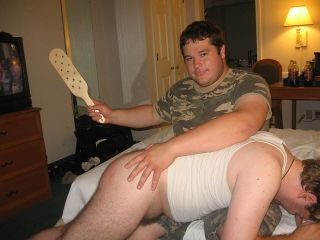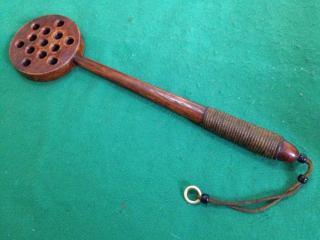 |
| Application of the palmatória across an adult boy’s buttocks creates nalgas rojas |
In yesterday’s National Paddling Week blogpost we shared Rob Bham’s adaptation of a Forrest Wickman Slate article on the invention of paddling. Today, we’re going to take a look at the palmatória , a stick used for Spanking as described in Wikipedia. Our search came from the start of a paragraph that said, “Soon paddling spread to Europe and Brazil—where they used a wooden paddle called the palmatória —and it wasn’t used only to discipline slaves and unruly sailors. Some of the first school students to be paddled were Irish students, who were paddled for failing to take off their hats.”
Let’s look at the internet for leads on what the palmatória does and what it’s history is.
According to Google Translator, “The palmator sometimes also called splint, is usually a wooden tool formed by joining the shapes of a circle connected to a rod or handle. It’s used in in schools by teachers in order to punish students by striking it on the palm of the errant student’s hand or buttocks.
Some palmators have holes in the circular area in order to increase the painful sensation. The holes serve to overcome the resistance of the air and increase the speed of the blow, thus increasing the pain and traces left on the skin after each blow.
At matriculation ceremonies in Brazilian schools, students presented the palmator to their teachers—as a sign of submission to the teacher’s authority.
Currently, its use is considered a crime in most Westernized countries—including in Portugal and Brazil—as is the physical punishment on students.Recently, however, the English Parliament has again debated the legitimacy of using physical punishment as a corrective educational measure for children—leading to much discussion.”
It turns out the original
Receiving a ‘bolo de palmatória‘ was one of the worst things that a student from the late and early twentieth century could get. Despite the name, the PALM-ator was also used on other parts of the body besides the palm of the hand.
You can purchase your very own Palmator from this website! Check it out:
—Palmatória – Comprimento: 45cm
Here’s the original language from the wiki, in case the google translator mangled the Portugese from which it was originally written.
“A palmatória por vezes também chamada férula, é um artefato geralmente de madeira formado por um círculo e uma haste. Foi muito utilizada no passado nas escolas pelos professores a fim de castigar alunos, golpeando-a na palma da mão do aluno castigado. Algumas palmatórias podem conter furos no círculo, a fim de aumentar a sensação dolorosa. Os furos servem para vencer a resistência do ar e aumentar a velocidade do golpe, aumentando assim a dor e vestígio deixado na pele por cada golpe.
 |
| El palmatória de cuero |
“Antigamente, nas festas de formatura, no Brasil, era costume os alunos presentearem seus professores com palmatórias, como sinal de submissão à autoridade.
“Atualmente, seu uso é considerado crime na maioria dos países ocidentais, entre eles Portugal e Brasil, bem como qualquer castigo físico infligido a estudantes. O último país ocidental a abolir o uso da palmatória foi a Inglaterra, em 1989. Recentemente, contudo, o parlamento inglês voltou a debater a legitimidade do uso dos castigos físicos como medida educacional corretiva em crianças, gerando grandes discussões.
“No Brasil, a palmatória passou a chamar a atenção no final dos anos 60, por conta de campanhas contra a violência infantil, e foi transformada em crime no final dos anos 70.”


